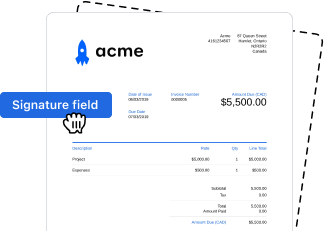eSignature Licitness for Assignment of Partnership Interest in United States
- Quick to start
- Easy-to-use
- 24/7 support
Simplified document journeys for small teams and individuals




We spread the word about digital transformation
Why choose airSlate SignNow
-
Free 7-day trial. Choose the plan you need and try it risk-free.
-
Honest pricing for full-featured plans. airSlate SignNow offers subscription plans with no overages or hidden fees at renewal.
-
Enterprise-grade security. airSlate SignNow helps you comply with global security standards.







Your complete how-to guide - e signature licitness for assignment of partnership interest in united states
eSignature Licitness for Assignment of Partnership Interest in United States
When dealing with the assignment of partnership interest in the United States, it is crucial to ensure the eSignature licitness in the process. With airSlate SignNow, you can streamline this procedure while staying compliant with all legal requirements.
How to Utilize airSlate SignNow for Assigning Partnership Interest:
- Launch the airSlate SignNow web page in your browser.
- Sign up for a free trial or log in.
- Upload a document you want to sign or send for signing.
- Convert your document into a reusable template for future use.
- Make necessary edits to your file by adding fillable fields or inserting information.
- Sign the document and add signature fields for the recipients.
- Click 'Continue' to configure and send an eSignature invite.
airSlate SignNow empowers businesses to streamline their document signing process with an easy-to-use and cost-effective solution. It offers a great ROI by providing a rich feature set at an affordable price point. Additionally, it is tailored for SMBs and Mid-Market businesses, ensuring scalability and ease of use.
Experience the benefits of airSlate SignNow today and simplify your document signing process with confidence!
How it works
Rate your experience
What is the e signature licitness for assignment of partnership interest in united states
The e signature licitness for assignment of partnership interest in the United States refers to the legal acceptance and validity of electronic signatures when transferring ownership interests in a partnership. This framework is governed by the Electronic Signatures in Global and National Commerce (ESIGN) Act and the Uniform Electronic Transactions Act (UETA), which establish that electronic signatures hold the same legal weight as traditional handwritten signatures. This means that when parties agree to assign their partnership interests electronically, such agreements are enforceable in a court of law, provided they meet certain criteria.
How to use the e signature licitness for assignment of partnership interest in united states
To utilize the e signature licitness for the assignment of partnership interest, users should follow a structured process. First, ensure that all parties involved are in agreement regarding the terms of the assignment. Next, prepare the assignment document, clearly outlining the details of the partnership interest being transferred. Using airSlate SignNow, users can upload the document, fill in the necessary information, and send it for signature. Recipients will receive a notification to review and eSign the document. Once all signatures are collected, the completed document can be securely stored and shared as needed.
Steps to complete the e signature licitness for assignment of partnership interest in united states
Completing the e signature licitness for assignment of partnership interest involves several key steps:
- Prepare the assignment document, ensuring it includes all relevant details of the partnership interest.
- Upload the document to airSlate SignNow and use the fill and sign features to complete any required fields.
- Send the document for signature by entering the email addresses of all parties involved.
- Each party will receive a notification to review and eSign the document electronically.
- After all signatures are collected, download the fully executed document for your records.
Legal use of the e signature licitness for assignment of partnership interest in united states
The legal use of e signatures for the assignment of partnership interest is firmly established under U.S. law. Both the ESIGN Act and UETA affirm that electronic signatures are legally binding, provided that the signers consent to use electronic means and the signature is linked to the document. It is important for users to ensure that their electronic signature process complies with these regulations to avoid disputes regarding the validity of the assignment. This includes maintaining proper records and ensuring that all parties have the ability to access and review the document before signing.
Key elements of the e signature licitness for assignment of partnership interest in united states
Key elements that contribute to the e signature licitness for the assignment of partnership interest include:
- Consent: All parties must agree to use electronic signatures.
- Intent: The signer's intent to sign the document must be clear.
- Association: The electronic signature must be linked to the document being signed.
- Record retention: A secure method for storing the signed document must be in place.
State-specific rules for the e signature licitness for assignment of partnership interest in united states
While the ESIGN Act and UETA provide a federal framework for e signatures, individual states may have specific rules or requirements that can affect the assignment of partnership interests. Users should familiarize themselves with their state’s regulations regarding electronic signatures, as some states may have additional provisions or stipulations that must be followed. Consulting with a legal professional can help ensure compliance with local laws and regulations.
-
Best ROI. Our customers achieve an average 7x ROI within the first six months.
-
Scales with your use cases. From SMBs to mid-market, airSlate SignNow delivers results for businesses of all sizes.
-
Intuitive UI and API. Sign and send documents from your apps in minutes.
FAQs
-
What is the e signature licitness for assignment of partnership interest in the United States?
The e signature licitness for assignment of partnership interest in the United States refers to the legal validity of electronic signatures in executing partnership agreements. Under the ESIGN Act and UETA, electronic signatures are recognized as legally binding, ensuring that your partnership assignments are secure and compliant.
-
How does airSlate SignNow ensure compliance with e signature licitness for assignment of partnership interest in the United States?
airSlate SignNow adheres to the legal standards set by the ESIGN Act and UETA, ensuring that all electronic signatures are compliant with e signature licitness for assignment of partnership interest in the United States. Our platform provides audit trails and secure storage to maintain the integrity of your documents.
-
What features does airSlate SignNow offer for managing partnership agreements?
airSlate SignNow offers a range of features for managing partnership agreements, including customizable templates, real-time tracking, and secure eSigning. These features enhance the e signature licitness for assignment of partnership interest in the United States, making it easier to execute and manage your documents.
-
Is airSlate SignNow cost-effective for small businesses needing e signature licitness for assignment of partnership interest?
Yes, airSlate SignNow provides a cost-effective solution for small businesses looking to ensure e signature licitness for assignment of partnership interest in the United States. Our pricing plans are designed to accommodate various budgets while offering robust features that enhance document management.
-
Can airSlate SignNow integrate with other software for partnership management?
Absolutely! airSlate SignNow integrates seamlessly with various software applications, enhancing your workflow for partnership management. This integration supports the e signature licitness for assignment of partnership interest in the United States by streamlining document processes across platforms.
-
What are the benefits of using airSlate SignNow for electronic signatures?
Using airSlate SignNow for electronic signatures offers numerous benefits, including increased efficiency, reduced paper usage, and enhanced security. These advantages contribute to the e signature licitness for assignment of partnership interest in the United States, ensuring that your agreements are executed swiftly and securely.
-
How secure is airSlate SignNow for handling sensitive partnership documents?
airSlate SignNow prioritizes security with advanced encryption and compliance with industry standards. This ensures that your sensitive partnership documents are protected while maintaining e signature licitness for assignment of partnership interest in the United States, giving you peace of mind.
Related searches to e signature licitness for assignment of partnership interest in united states
Join over 28 million airSlate SignNow users
Get more for e signature licitness for assignment of partnership interest in united states
- Boosting online signature legitimateness for Sport ...
- Ensuring Online Signature Legitimateness for ...
- Online Signature Legitimateness for Pharmaceutical in ...
- Increase online signature legitimateness for ...
- Boosting Online Signature Legitimateness for ...
- Online Signature Legitimateness for Pharmaceutical in ...
- Unlocking Online Signature Legitimateness for ...
- Enhance online signature legitimateness for ...




























